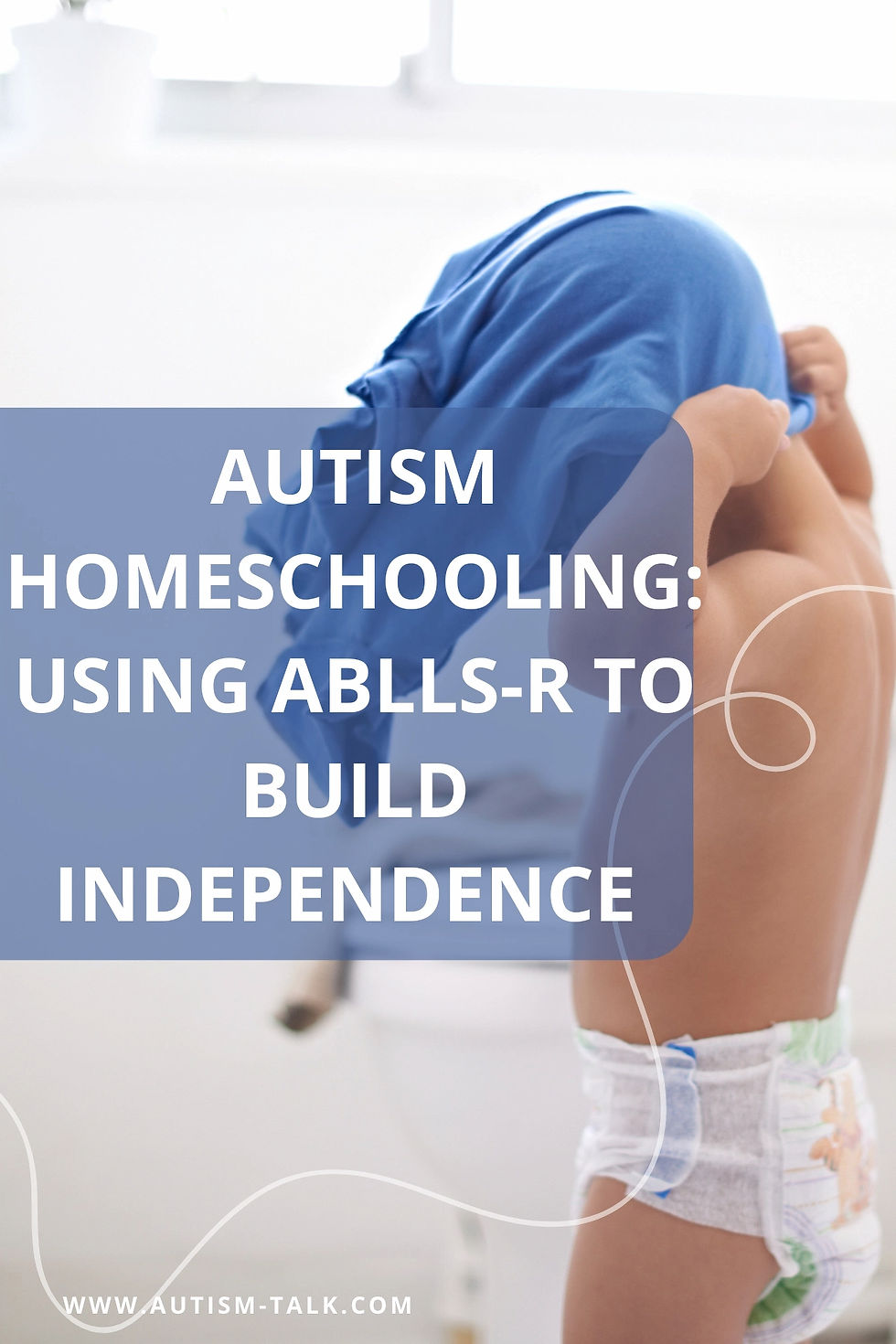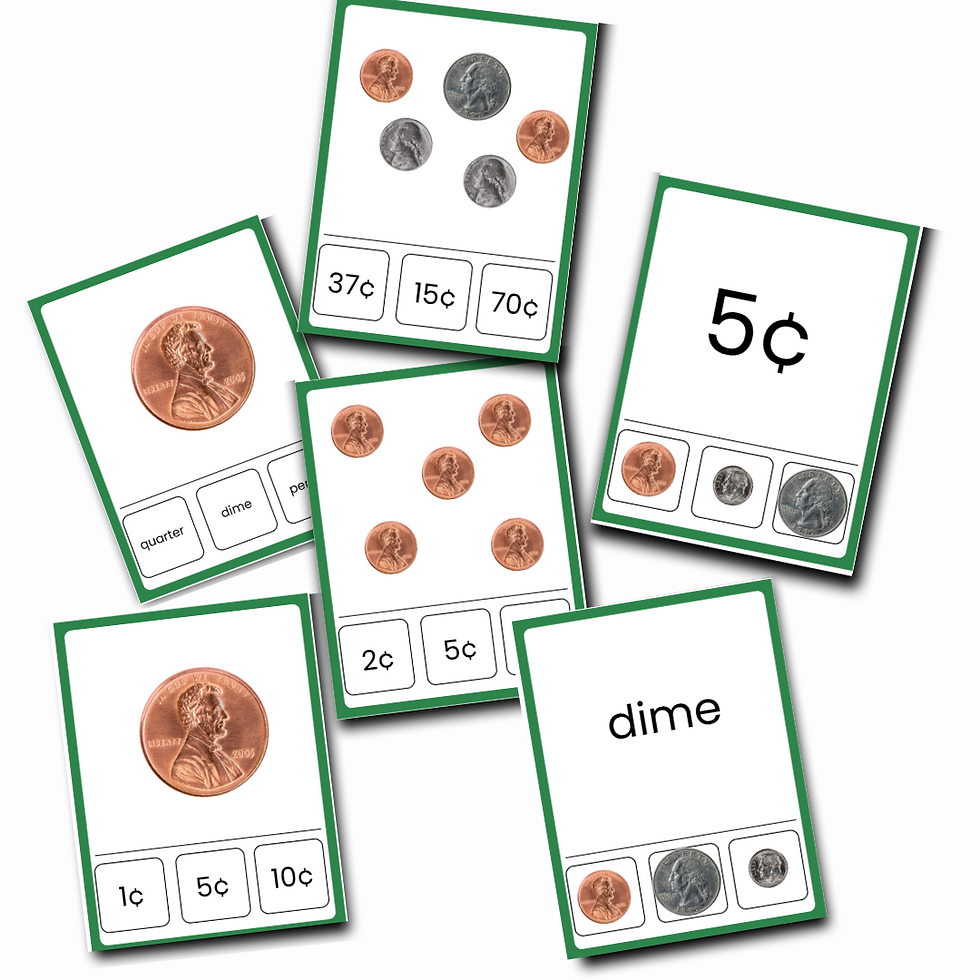Teaching Autism Self-Help Skills from ABLLS-R in a Homeschool Program
- Autism-Talk

- Jan 30
- 6 min read
Updated: Mar 31

Learn how to teach autism self-help skills at home using ABLLS-R. This guide covers toileting, dressing, money skills, and homeschooling autistic children.
Table of Contents
What Is ABLLS-R and Why Is It Useful for Parents?
The ABLLS-R (Assessment of Basic Language and Learning Skills-Revised) is a widely used tool to assess and teach essential skills in autistic children. It covers 25 skill areas which can provide a structured roadmap for developing functional, communication, and social skills. See this previous post
While commonly used in schools and therapy settings, the ABLLS-R can also be a useful resource for homeschooling parents. It breaks down each skill into small, manageable steps, making it easier for parents to teach at home.
Many families find that using ABLLS-R to teach independence skills gives them a structured approach for homeschooling autistic children, especially if they do not have access to a BCBA or special education teacher to help them target possible goals.
💡 Want to learn more? Check out:
Why Teaching Autism Self-Help Skills at Home is Essential
Many parents of autistic children choose to homeschool because traditional schools focus heavily on academics while neglecting life skills. However, autism self-help skills—like toileting, dressing, eating, and money management—are crucial for long-term independence.
📌 Research Behind Teaching Daily Living Skills at Home
Kanne et al. (2011): Autistic children often have significant delays in daily living skills, even if they have average or above-average intelligence.
Bal et al. (2015): Adaptive skill deficits persist into adulthood, making independence more challenging.
Alvares et al. (2020): Daily living skills—not IQ—are the best predictor of future independence.
Benefits of Teaching Autism Self-Help Skills at Home
✔ Encourages independence – Learning to dress, use the toilet, and prepare meals helps children become more self-sufficient.
✔ Reduces caregiver stress – Children who can complete tasks independently require less assistance in daily routines and improves self-confidence.
✔ Improves emotional regulation – Predictable routines around hygiene, eating, and dressing lower stress and meltdowns.
Now, how to teach these skills!
How to Teach Self-Help Skills to Autistic Children Using ABLLS-R
Toileting
Why It’s Important:
Toilet training autism is essential for hygiene, dignity, and independence. Many autistic children struggle with sensory sensitivities, so structured, step-by-step teaching is key.
Fun & Practical Ways to Teach Toileting

Use a visual schedule with pictures showing each toileting step.
Introduce a social story to explain bathroom expectations and address fears such as toilet flushing or fear of pooping in the toilet. These stories can be easily written but they are also available on many topics on ETSY or TPT.
Incorporate special interests for instance if you have a child interested in dinosaurs, use a dinosaur to model using the toilet or let a child earn stickers of favorite video or TV characters.
Use videos and music YouTube is your best friend when it comes to autistic children and toilet training. Look for videos and songs that address toileting specifics such as stopping activities to use the restroom or remembering to wash hands.
Use a reward system It's important to remember that because children with autism may be facing issues with sensory sensitivities or tackling fear of change they may need more incentive systems than a neurotypical child.
Consider a smaller item just for sitting on the toilet, something special for pooping in
the toilet, etc. Don't forget to think outside the box for rewards such as social events (calling a loved one or visiting a neighbor the child likes for instance or jumping outside on a trampoline or swing set.
📌 Resources: Toilet Training Social Story Bundle | Toilet Training Visual Supports

Dressing
Why It’s Important:
Dressing independently helps children develop fine motor skills, self-confidence, and self-expression.
Fun Ways to Teach Dressing
Use dressing boards or dolls to practice buttoning and zipping.
Create a dressing visual schedule This can reduce some of the verbal and physical prompting that we often fall into with autistic children as well as decrease power struggles. You can make your own with photos that your child will recognize or purchase one of these available on ETSY or TPT.
Use social stories to reinforce dressing expectations and tackle specific issues such as asking for help without getting upset.
Play "Dress Up Simon Says" to make dressing practice more fun when children have acquired the motor skills to get dressed but are resistant for other reasons.
Race to see who can get their jacket on first, shoes on first, etc. This is a classic motivational technique for all children but it still surprisingly effective.
Set a timer and offer a small reward for getting dressed before the timer goes off
Provide clothing options that accommodate sensory preferences. Encourage children to understand what is comfortable or uncomfortable and teach them how to communicate these needs, for instance, I don't like the tag or I don't like how shorts feel on my exposed legs.

Eating and Mealtime Independence
Why It’s Important:
Many autistic children have issues around foods and eating that can make mealtime stressful for the entire family. Building mealtime skills reduces family stress and improve the health of children who may be resistant to trying new foods.
Fun & Practical Ways to Teach Eating Skills
Use adaptive utensils many children with autism have low muscle tone and/or coordination issues that make using utensils such as spoons or forks difficult. You can find a variety of adaptive tools available on Amazon or specialty OT online stores. If you have access to an OT you can ask them for recommendations after they watch your child eat to see what difficulties they are having.
Practice with sensory-friendly foods Keep mealtimes low stress and encourage exploring foods even if child is not yet ready to eat the food, for instance smelling the food, pouring the food, touching the food.
Play "Feed the Puppet" where children pretend to feed a stuffed animal.
Use a visual meal schedule to encourage children to gradually eat a broader variety of foods.
Use a Social Skill Story to help children understand why it is important to eat different foods, stay at the table while eating, etc.
Money Skills
Why It’s Important:
Understanding money is essential for independent living, especially as children get older and we have a tendency to forget to continue working on self-help skills. Many autistic children benefit from hands-on, visual learning to grasp coin values and transactions.
Fun & Practical Ways to Teach Money Skills
Use adapted interactive books These are books where the child must answer a question on each page and place the correct piece from the book pieces. The pieces are usually attached with Velcro. You can purchase books like these on ETSY or TPT.
Play games with coin flashcards Games like Memory where a child must match the picture of the coins with the amount they represent or a game where children reach in a sensory bin and take out actual coins and either match them to a picture of that coin or to the money amount of the coin.

Set up a pretend store where children practice buying and selling items. This sounds like a lot of work but can actually be done fairly simply. Just search the bottom of your purse for extra coins and place small Post-it notes with amounts on some toys that are set up. Children seem to never tire of this and love the aspect of getting to handle actual coins.
Use real-world experiences (e.g., counting change at a grocery store or letting child put credit card in the snack machine).
Conclusion
Using ABLLS-R in a homeschool program allows parents to effectively teach autism self-help skills like toileting, dressing, eating, and money management. With fun, structured learning strategies, autistic children can develop confidence, independence, and essential daily living skills.
References
Alvares, G. A., Bebbington, K., Cleary, D., Evans, K., Glasson, E. J., Maybery, M. T., & Whitehouse, A. J. (2020). The misnomer of 'high-functioning autism': Intelligence is an imprecise predictor of functional abilities at diagnosis. Autism, 24(1), 221-232. https://doi.org/10.1177/1362361319852831
Bal, V. H., Kim, S. H., Cheong, D., & Lord, C. (2015). Daily living skills in individuals with autism spectrum disorder from 2 to 21 years of age. Autism, 19(7), 774-784. https://doi.org/10.1177/1362361315575840
Kanne, S. M., Gerber, A. J., Quirmbach, L. M., Sparrow, S. S., Cicchetti, D. V., & Saulnier, C. A. (2011). The role of adaptive behavior in autism spectrum disorders: Implications for functional outcome. Journal of Autism and Developmental Disorders, 41(8), 1007-1018. https://doi.org/10.1007/s10803-010-1126-4
%20(21).png)












Comments